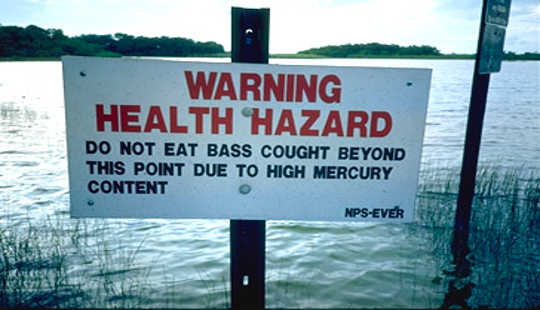
Mercury contamination is widespread across western North America in the air, soil, lake sediments, plants, fish, and wildlife, according to new research.
Scientists on the Western North America Mercury Synthesis team report the finding online in a series of articles in Science of the Total Environment. Key findings from the study include:
- Contamination with methylmercury, the toxic organic form of the metallic element, in fish and birds is common in many areas across western North America.
- Fish and birds in many areas were found to contain mercury concentrations above levels considered toxic to them.
- Forest soils typically contain more inorganic mercury than soils in semi-arid environments, yet the highest levels of methylmercury in fish and wildlife tend to occur in semi-arid areas.
- Land disturbances, such as urban development, agriculture, and wildfires, are important factors in releasing stored mercury from the landscape, potentially making it available for biological uptake.
- Land and water management activities can strongly influence how methylmercury is created and transferred to fish, wildlife, and humans.
“Mercury is widespread in the environment and under certain conditions poses a substantial threat to environmental health and natural resource conservation,” says Collin Eagles-Smith, a US Geological Survey ecologist and the team leader.
Paul Drevnick of the University of Michigan led a group that compiled mercury records from 165 dated sediment cores collected from 138 natural lakes across western North America for one of the papers in the series. Lake sediments are considered faithful recorders of historical mercury accumulation rates.
The researchers found that mercury accumulation rates in western lake sediments have increased, on average, by four times from 1850 to 2000 and continue to increase today.
Human activities
Atmospheric deposition from human activities—especially emissions from coal-fired power plants and artisanal gold-mining operations—is responsible for much of the mercury that ends up in western lake sediments. Other sources include industrial and municipal wastewater.
Airborne mercury that crosses the Pacific Ocean from Asian sources also makes its way into those western lake sediments, says Drevnick, an assistant research scientist at the University of of Michigan’s School of Natural Resources and Environment and at the University of Michigan Biological Station.
“Mercury emitted from power plants in Asia is incorporated into the hemispheric pool of atmospheric mercury and is affecting all of western North America,” Drevnick says. “That is the reason why—despite local, regional, and national efforts to reduce mercury emissions in North America—we continue to observe increased mercury loading to lakes in the West.”
Great Lakes in recovery
Drevnick has also been involved in efforts to compile, analyze, and interpret mercury data from the Great Lakes, a region that offers a stark contrast to the US West. In the Great Lakes region, mercury levels in lake sediments peaked in the 1980s and have been declining since then.
“As far as mercury in the Great Lakes region, we are in a recovery phase,” he says. “We have a good understanding of the problem here and have eliminated point sources to water bodies, such as chlor-alkali plants and pulp and paper mills that used mercury in industrial processes. Also, we have controlled emissions to the atmosphere.”
Up the food chain
Mercury is a naturally occurring metal that poses a health threat to humans, fish, and wildlife. Its most toxic form, methylmercury, primarily affects the nervous and reproductive systems and is particularly harmful during early development.
Inorganic mercury moves from the atmosphere and the land surface into waterways where, under the right conditions, it is converted to methylmercury by bacteria. Methylmercury levels in water generally do not pose a direct threat to fish, wildlife or humans. But methylmercury increases in concentration as it moves up the food chain, reaching its highest levels in predators and long-lived species.
In North America, human exposure to methylmercury primarily occurs through the consumption of fish, which complicates public health guidance because eating fish provides numerous health benefits.
“The movement of mercury through the landscape—traveling between the air, ground and water to plants, animals, and ultimately to humans—is extremely complex,” says Eagles-Smith of USGS.
“This series of articles helps further our understanding of the processes associated with that complexity in western North America, highlights where knowledge gaps still exist, and provides information to resource managers that will help with making informed management and regulatory decisions based in science,” he says.
The body of works presented in the Science of the Total Environment papers was conducted as part of the Western North America Mercury Synthesis Working Group and supported by the USGS John Wesley Powell Center for Analysis and Synthesis.
The working group includes partners from US and Canadian federal, state, and provincial agencies; academic institutions; and nongovernmental organizations. Primary funding support came from the US Geological Survey, the National Park Service, and the US Environmental Protection Agency, with additional support from the individual authors’ organizations.
Source: University of Michigan
Related Books:
at InnerSelf Market and Amazon

























